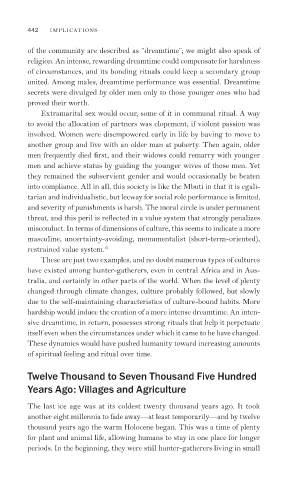Page 477 - Cultures and Organizations
P. 477
442 IMPLICATIONS
of the community are described as “dreamtime”; we might also speak of
religion. An intense, rewarding dreamtime could compensate for harshness
of circumstances, and its bonding rituals could keep a secondary group
united. Among males, dreamtime performance was essential. Dreamtime
secrets were divulged by older men only to those younger ones who had
proved their worth.
Extramarital sex would occur, some of it in communal ritual. A way
to avoid the allocation of partners was elopement, if violent passion was
involved. Women were disempowered early in life by having to move to
another group and live with an older man at puberty. Then again, older
men frequently died first, and their widows could remarry with younger
men and achieve status by guiding the younger wives of those men. Yet
they remained the subservient gender and would occasionally be beaten
into compliance. All in all, this society is like the Mbuti in that it is egali-
tarian and individualistic, but leeway for social role performance is limited,
and severity of punishments is harsh. The moral circle is under permanent
threat, and this peril is reflected in a value system that strongly penalizes
misconduct. In terms of dimensions of culture, this seems to indicate a more
masculine, uncertainty- avoiding, monumentalist (short- term- oriented),
restrained value system. 15
These are just two examples, and no doubt numerous types of cultures
have existed among hunter-gatherers, even in central Africa and in Aus-
tralia, and certainly in other parts of the world. When the level of plenty
changed through climate changes, culture probably followed, but slowly
due to the self-maintaining characteristics of culture-bound habits. More
hardship would induce the creation of a more intense dreamtime. An inten-
sive dreamtime, in return, possesses strong rituals that help it perpetuate
itself even when the circumstances under which it came to be have changed.
These dynamics would have pushed humanity toward increasing amounts
of spiritual feeling and ritual over time.
Twelve Thousand to Seven Thousand Five Hundred
Years Ago: Villages and Agriculture
The last ice age was at its coldest twenty thousand years ago. It took
another eight millennia to fade away—at least temporarily—and by twelve
thousand years ago the warm Holocene began. This was a time of plenty
for plant and animal life, allowing humans to stay in one place for longer
periods. In the beginning, they were still hunter-gatherers living in small

